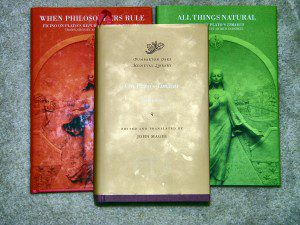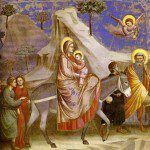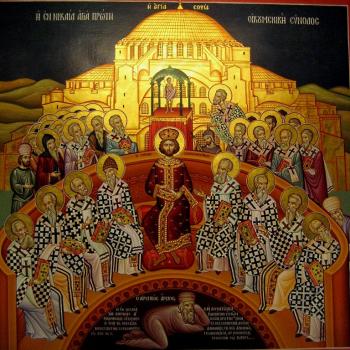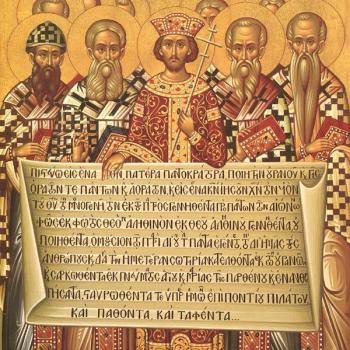
During the early medieval era, many of the Greek classics had not been translated into Latin, leaving the West with an imperfect and partial understanding of the philosophical tradition. This is not to say they were left completely in the dark — some important texts had been translated into Latin and were widely read and used by Western intellectuals, among which, was the partial translation and commentary of Plato’s Timaeus by Calcidius. Within that translation was made available two significant portions of the Timaeus as well as a commentary helping to explain the text in relation to the whole of Plato’s thought, giving notes on other dialogues and incorporating insight from the Platonic tradition as it existed in Calcidius’ time. While studied and read by scholars, this important commentary had not, until recently, been translated into English, leaving a major lacunae for those who do not have the skills, or time, to read the original text, and yet would find it of interest.[1]
I am one such person. I’ve long had an interest in the text, and though I have studied Latin and can work with Latin texts, I am not a fast translator and it would have taken a very long to go through such a large text, time which I felt was better used in other places. For, though I have contemplated the text and its author from time to time, speculating on its possible importance in relation to St. Constantine and his conversion to Christianity, it has been for me more of a curiosity than a serious scholarly interest. This is not to say I find no value in my notions: I do, and so from time to time, I return to them, and see if anything new has been published which can help them take better form. In this way, the identity of Calcidius and the reason why he did his translation and commentary on the Timaeus has remained a point of interest for me which I turn to from time to time, and now that the text is available in translation, next to its Latin original, I once again turn to my speculations, and consider the riddle anew, hoping as I do so, I might spark further interest in Calcidius in one of my readers, who might take the idea further than I, and explore the possibilities which I raise further, to see if they can be further complemented or hindered by solid research.
To be sure, much of the commentary probably will not be very useful for the ordinary reader, such as his lengthy exploration on Plato’s cosmology, with all the mathematical commentary that went with it. And yet, it is not without merit and for those who would find it intriguing and important for their scholarship, such as those interested in the history of ancient science, they never have another resource to use and explore. They will find considerable portions of the text which explore Calcidius’ understanding of Plato’s cosmology complete with mathematical philosophizing that comes out of Pythagorean understanding of the relationship between numbers and reality. It is not easy reading, and for many, it might be worthwhile to get the basic argument by skimming through such portions of the text, until they find and latch onto something which strikes their fancy. For not only do we have cosmological concerns, we have metaphysical and religious concerns, especially in the “Second Part” of the commentary which deals with the second significant fragment Calcidius translated from Plato. Calcidius’ approach to philosophical questions, such as questions over the nature of creation, free will and providence, the relationship between spirit and matter, and the like, should intrigue those interested in classical philosophy or theology. They will find in part answers which foreshadow the ways later authors like Augustine, Boethius or even Bernard Silvestris deal with them, perhaps serving more as a primer to their thought than sometimes considered.[2]
But I am getting ahead of myself here, giving reasons why Calcidius is important and worthy of study. But, as hinted at above, there is another reason why he is important, and should be studied, not just by those interested in the development of medieval philosophy, but also in the development of Christian theology as a whole, and that lies with his possible connection with Ossius of Cordova, and the early Christian engagement and adaptation of classical civilization for the sake of new converts like St. Constantine. That is, if the answer to the riddle of “who is Calcidius” is as tradition suggests, that he was the archdeacon to Ossius of Cordova, then he find himself at the center of the Christian tradition and his writings, curious as they offer, give us greater insight to the philosophical principles which lay behind the debates of the early 4th century. Nonetheless, while I think this identity is correct, and I will offer some reasons in my discussion here why I think this is so, I am not going to give the definitive answer here, but only the one I think is the most reasonable conclusion based upon what I have read before and what struck me after my initial reading of the text.[3]
As John Magee explained in his introduction, scholars have proposed a few possibilities as to who they think Calcidius might but and the answer often lies with the one he wrote the text for, Ossius (Hosius). Again, the traditional answer, and the one I believe is right, is that Calcidius was a friend, possibly an archdeacon, under Ossius of Corodva. That Ossius was a confessor-bishop who had survived brutal torture before becoming one of the first asked by Constantine to come to him and help teach him about the Christian faith. Ossius not only did as Constantine asked, he also served as the first major arbitrator for the Christians, helping to referee many of Constantine’s projects, such as determining who should get the money and land Constantine wanted to return to the Christians (with some schismatic and heretical groups finding Ossius denying them such funding, causing them to be bitter and write harshly against him). More importantly, he was sent to Alexandria to find out what was happening with Arius, and to help stop the emerging conflict before it got out of hand. Ossius went, initially uncertain as to what the debate was about, but when he met with the Patriarch, Alexander, he quickly sided with him against Arius, befriending Athanasius in the process. This would eventually lead to the calling of the Council of Nicea, which Ossius not only would preside over, but where he would serve as the leader writer of the Nicene Creed. [4]
I believe, having read the text itself, the case for Calcidius being connected with Ossius of Cordova is only strengthened. First, the introduction to the work was a letter he wrote to Ossius, giving us the foundation by which we know someone named Ossius was involved. But then, in the letter itself, he suggested that Ossius himself would have been better suited to the translation work than he, but he did the work after being obligated to do it by Ossius. Here, we get a sense that Ossius was in a position of authority, and he was recognized as being intellectually competent for the task at hand. Third, in the text we find considerable discussions of Christian theology as it connects to Plato’s philosophy, showing an obvious interest in using the text as a place of dialogue between Christian thought and Platonic philosophy. [5] But also, the text seems to discuss such matters in a way which follows theological ambiguity found before Nicea, and would be expected to be ruled out and no longer used after. For the text, like many ante-Nicene texts, hints of subordinationism, of the Father being greater than the Son, while recognizing the eternal connection between the two – that the Son has no origin in time. This can be seen in the way Calcidius talked about the Wisdom of God (which at this point in time, would have been used to talk about the Logos or Son of God), who is said to be “made” but not in time, the ambiguity of which neither an Arian nor a Nicene would approve:
There is nevertheless, one beginning of all things, concerning which Solomon says in Proverbs, “God created me as the pathway of his progression, in reliance upon which he might effect his divine works, and he established me before the origin of the world and the earth and the foundation of the deep, before the flowing of springs and the massing of mountains,” explicitly indicating that divine wisdom came before heaven and earth were made, and that the same divine wisdom was the primordial origin of the universe. And from this it is clear that wisdom was indeed made by God but not at any point in time, for there was no time when God was without wisdom, and that human thought necessarily perceives God before wisdom owing to the superiority of his nature, since the possessor of a thing is known first, only then does the thing itself come to be known. And this is how we should take the term “beginning.[6]
Especially in connection to the way Calcidius explains Wisdom, it is unlikely that a Christian after Nicea would produce a text like this and leave it without comment. That is, we would expect him to go Arian and talk about how being made establishes Wisdom as a creature, or he would talk about how his being is outside of time and with God for eternity, that Wisdom is therefore not a creature and so God. Here, instead, we have a vague formulation which can show us how and why the Arian crisis itself could emerge. For this reason, I think later dates, and so Ossiuses who lived long after Nicea, should be ruled out, leaving us the traditional answer that he was Ossius of Cordva as the most likely candidate. And this would also help us understand why Ossius would be interested in having the Timaeus translated into Latin, because he would be one who worked with Latins who had little to no working knowledge of Greek, Latins who also were involved with the governance with Rome and would like a guide which suited their interests and understandings that would help them connect what they already know with Christian theology. Calcidius’ translation could easily have served as a kind of introductory text which would be able to introduce Christian theology, giving hints and suggestions to the kinds of beliefs Christians held in a way which raised up their stature by putting them within a commentary that connected them to Plato. And for those who, following Constantine, wanted to have a better grasp of Christian thought, this would also be a way to do so for them – give them something they know in part while connecting it to what they don’t know and want to learn from the Christian tradition. [7]
What I have suggested is speculative in nature, though I think, best fits what we know of the text and helps explain what its true purpose was (which, with the identity of the author, is a question which is often raised by scholars). It will take more research and exploration to give the thesis justice; but now, with a translation, it is a project which many can join in, not necessarily as specialists, but as amateurs who might now catch something that experts would otherwise miss – something which will stick out more to them, now that they can read Calcidius, than before, when they had to rely upon scholars glossing over minutiae of the text while ignoring the big picture in the process.
[1] Calcidius, On Plato’s Timaeus. ed. and trans. John Magee (Cambridge, MA: Harvard University Press, 2016).
[2] Indeed, one can see Calcidius working on the relationship between time and eternity, between the mind of God and creation, in a way which anticipates the answers found in Augustine.
[3] To be sure, my first full reading does not come without bias – I have read several scholarly discussion on portions of the text before, as well as writers explaining why they thought Ossius of Cordova was behind Calcidius’ project; they were convincing to me before I read the text, but now, having done through it myself, the notion has only reinforced itself, though now I think when the text was written is clearer to me than before.
[4] Other possibilities raised by Magee include a Patrician with the name Ossius, a Comes Sacarum Lagitionum at the end of the 4th century in Constantinople, a magister also in Constantinople at the end of the fourth century, or a Hosius who worked with Eutropius against Tribigild in 399. (see viii-ix of the translation).
[5] And in doing so, he will constantly reference the reader’s (Ossius) knowledge of these facts, such as when he wrote:
There is also another recorded tale, one more holy and venerable, according to which with the rising of a certain star there was portended, not disease and death, but the descent of a venerable God to bestow the grace of salvation upon mankind and mortal beings. Men from among the Chaldeans who were undoubtedly wise and skilled in the observation of celestial phenomena are said, on having observed the star during a night journey, to have gone in search of the new birth of God and, on discovering the child in the state of majesty, to have venerated Him and offered prayers befitting a God of such greatness. These matters are much better known to you than to others (pg.331).
[6] Ibid., 559.
[7] This would mean, the text is similar in scope and purpose with what we find Matteo Ricci doing with Confucian thought in China.
Stay in touch! Like A Little Bit of Nothing on Facebook:
A Little Bit of Nothing










